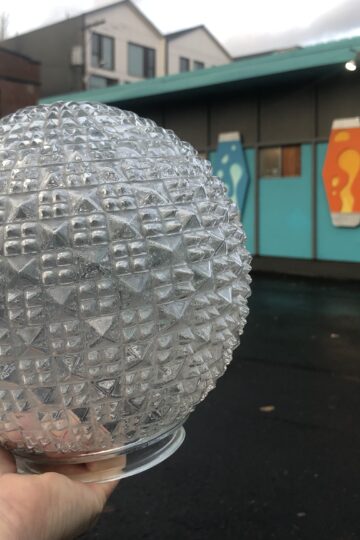To Leave Your Lights On, Or Turn Them Off? -- An Enlightening Answer
The following is a reprint of a previously published post. Enjoy!
Here's the never-ending electrical dilemma:
When leaving a room for just a short period of time, should you turn the lights off or leave them on?
Some will argue to always turn off bulbs, even if a room will be re-entered in the near future.
Others counter to leave them on, because they believe it takes more energy to restart a bulb than to simply leave it on.
Opinions are curiously strong on this subject, almost as bad as the toilet paper roll dilemma. (spin over, or under?)
Discovery Channel's "Mythbusters" television show addressed this issue from a scientific standpoint.
Here's what they came up with:
"Hypothesis: The "start up" burst of energy consumed more energy than leaving the lights on continually.
Procedure/Experimental Design: The MythBusters test common type of lightbulbs: incandecent, flourescent, metal hylide, and even an LED.
Results: Even with the flourescent bulb having the largest start-up surge, needing to be off for 23 seconds before it is more energy efficient to leave it off, it is still a small amount of time before it is more energy efficient to leave them off.
Conclusion: It is better to turn the lights off when leaving the room even for a brief instant."
So there you have it.
Turn your lights off unless you are coming back within 23 seconds.
For me though, I am highly distractible and likely to find something to prevent my 23 second return. (A shiny pebble or juicy e-mail perhaps?)
The toilet paper direction debate? Finer minds than mine have failed to bring consensus, so I'll just have to leave this one to those fancy-schmancy think tank folks.
Katy Wolk-Stanley
"Use it up, wear it out, make it do or do without."






I believe the Car Talk guys did a similar (probably not as scientific) test on when you should keep your car running vs. turning it off. Their answer was around 30 seconds. More than that and the energy savings is in turning it off and back on. Less than that and you should leave it running.
The answer to this question changes with technology - the older the car, the longer the period. A few decades ago it was several minutes. A mechanic told me that for recent models it's now 15 seconds.
I have no idea what it is for hybrids or electric cars.
Thank you for this lightbulb moment! Very informative.
As for the TP question, I prefer over the top, no matter what the experts say. It just makes more sense and looks better somehow.
For pet owners, the answer to the TP question is: However it *doesn't* entice your pet to attack and destroy entire rolls of TP!
Haha You're absolutely right! Thankfully our cat has never discovered the fun in it.
This reminds me of an episode of that ridiculous show "Extreme Cheapskates" where a woman uses a SINGLE light bulb inside her home, never using any other light source she gets from than the one bulb she screws in and out around the house as she moves from room to room. Cuckoo for Cocoa Puffs, I'd say!
Take that, Mythbusters! 🙂
ROFL I hate I missed that episode! 😀
That show is nothing but fake. Believe me, I know.
Is it bad that I love that show even though it's redic?
Everything about it screams "FAKE!" To me.
With the heat and humidity in our part of the country, we cannot live without our ceiling fans. At our house we argued for years about whether to leave a ceiling fan on or off when you are not in the room. I was on the side that it helped to circulate air and keep the whole house at a more consistent temperature house wide. My husband said if you weren't in the room to feel the cooling effect, then it was wasted electricity.
About a year ago our electric co-op's newsletter addressed the topic, and my husband has been right all along. I now turn off the ceiling fan if I'm leaving the room and not planning to return relatively soon.
However, constantly turning on and off CFLs dramatically reduces their lifespan. I haven't done a full analysis, but I suspect from an overall environmental standpoint, you are better off leaving them on for short windows of time. I'm not sure about the overall economics.
Glad to have the definitive answer--also glad my 90 year old father does not use a computer or read blogs, or he would already have sent me the "I told you so" email!
my dilemma is with the furnace...
when I leave the house for the day (12-16 hours) should I leave the furnace set at a cool temperature or completely off?
Is it better to let the house cool down to the chilly 40s, and it takes quite a while to bring it up to my preferred 65 degrees.
OR
Should I leave it set to 50 burning gas the whole time the house is empty but only need a short time to bring it up to 65?
I wonder if Adam & Jamie ever tackled that one?
In terms of saving money running the furnace, you're better off to leave it off during the day. However, as you said, then you are uncomfortable for quite some time while the house warms back up, and it is up to you whether the extra cost is worth the comfort. You also want to make sure it stays warm enough that water pipes won't freeze and that it isn't too chilly for pets or houseplants.
If you can set it on a schedule (even the dumbest smart thermostats have this function, although some are more complicated than others), simply set it to turn off when you leave and back on to the desired temp starting 30-60 minutes prior to your expected return, depending on how cold it will end up getting.
Good to know. I do turn things off so often that I worry about the effects of that. Glad to know it takes electricity and, of course, the roll goes over and down in the front.
As far as the TP debate goes, I'm just thrilled when someone actually puts it back on the roll. No matter the direction.
I had a comment but it disappeared. (sad face).
I turn lights off when I leave a room for good, but leave them on when I'm going in and out. I use LED's, and I figure I'm not wasting that much. Besides, at night, a broken bone caused by stumbling around in the dark to find the light switch is much more expensive than leaving the light on a few minutes while I'm gone.
TP -- we purchased a "slide on, slide off" solid spindle that is vertical. There is no over or under debate now at our house and no fussing and cussing about trying to fit a spring-loaded spindle in it's little holder ends. Also no fussing about husbands who just sit the roll on the back of the toilet rather than fight the spring-loaded spindle type. We saw a vertical TP holder in use at Lehman's Hardware in Ohio and knew we had to get one for our house which we were building at the time. Love it!
We bought a slide on-slide off spindle toilet paper dispenser. Then our Irish wolfhound learned to use his nose to knock the roll off the spindle. Makes it much easier for him to drag the roll out his dog door into the back yard--with the spring-loaded one, he had to admit defeat and just chew off what he could while the roll was still trapped in the dispenser. Then he learned how to lift up the closed toilet seat so he could drink out of the toilet. He finally trained us to close the bathroom door behind us as we leave it, which put an end to him vandalizing the bathroom. Luckily, he is pretty much the perfect dog in every other way.
We shut the door, too, to keep the cat from sleeping in the clean folded towels on the shelves. Gotta love those pets! Your dog sounds so cute.
Seems like I have been doing it the right way 🙂
It's parental habit for me now. My parents taught us to turn off the lights, unless we were just going to another room for a short period of time.
Hubby? He's infuriatingly anal about the lights being off. So anal, in fact, that he will turn off the light over the stove when I'm cooking, if I'm not standing AT the stove at that moment. He's pissed me off so bad doing that at times, I've entertained throwing the food at him and leaving.
So, needless to say, I don't mind saving money by being frugal with electricity but don't get overly anal in my house or you might be wearing your dinner.
The paper roll thing - I like it over, it's easier to grab. 🙂
Vickie, As a true optimistic realist 😉 at least your husband will turn said lights, or any light for that matter, off. I'd be certain my husband must have lived outside where his exposure to electricity was nonexistent except for the fact I know both of his parents to prove me otherwise. If I'm away for even an hour in the evening, I come home to at least 5 lights on in our house...and the kids are usually in bed by then! It's the craziest thing I've ever seen. I need to get out more *wink* but well then, you know, I'd return to all the lights on, so...*rolling my eyes* hahaha. I'm chalking it up to him being an absent minded professor?? Sigh. Heidi
P.s. I did get a good chuckle out of your husband turning off the stove light if you aren't right at the stove. Although, I'm sure you aren't always laughing *wink*
You're right, I need to look at the positive side. He's pretty thrifty and a good saver.
It's possible the times he turned the stove light off he was doing a passive/aggressive thing. I've noticed when he's angry or irritated he gets picky about the dumbest things.
We learn to take the good with the bad! 😉
So true, Vickie re: taking the good with the bad. My husband is the one who may literally "keep the lights on" in our home, but he is also the one who figuratively does as he is the one between the 2 of us who makes almost all of the money and pay for the lights to be on!!! I should have added that in my original post. I'm incredibly grateful for that! So, even if I complain about the light usage, I'm quick to remember he pays for them (although he says it's all "ours", and I appreciate that too) and quite frankly, could make so many worse choices that could be financially devastating. I'll endure the little stuff, knowing it could be big stuff and actually bad. 🙂 Heidi
For the lights that turn on/off with a switch, we usually turn them off whenever we leave a room for any amount of time. But my living room, hall closet and laundry closet all have lights that you have to yank on the chain to turn on/off. Those, I tend to leave on until I am completely done because I can barely reach them as it is. Also, the light above my kitchen sink flickers and takes a moment to turn on, so I tend to leave it on all or most of the day.
Being diligent about turning off lights and using central heat and air judiciously made a huge difference in our power bill this year while I wasn't working. Now that I'm working again, the only light I leave on is in the kitchen because the dogs are in there and I hate the idea of them being in the dark when I leave.
Personally I'm a fan of over-the-top way of hanging toilet paper, but the cat likes it that way too, so we do it the other way to thwart her. 🙂
I do not know the technical details, but this sounds a lot light the misconception of leaving the fridge door open or a hard drive spinning 24/7.
The fridge door open turns off the fridge, but it will work harder to lower the temperature - fridges auto turn off and on to maintain temperature.
Hard drives use more energy to spin up, but they only need the energy they loose from spinning down which they do naturally without the power to sustain them. So, unless you are "breaking" the momentum, you are not using more energy to spin them back up, unless there is something to do with physics that makes it so.
I doubt a light bulb uses more energy to be turned on and off.
First, with older bulbs, the reason they get so hot is the waste energy heat from the resistance. The reason temperature reaches equilibrium is because the hotter it gets the faster it loses heat, not because it becomes more efficient being left on. (Laws of physics)
With LED lights, they use a lot less energy and waste less energy in heat.
Going back to the old light bulbs. It is possible they have capacitors that get discharged when they turn off and get filled when they are turned back on, giving the illusion of uses more energy but I doubt that equates to anything as LED lights use less power.
Again, with LED lights, the warming up process is the by-product of the useful energy transferred to heat.
The reason why I was looking for this is:
1) turning on off lights takes time
2) LED lights consume little energy
3) does turning them on and off wear them out, requiring more replaced = more cost = more waste of physical product.
Though, for number 3) people say this about hard disk drives and why it is not supported by TrueNAS. I think that:
1) desktop HDDs spin up and down every day no problem
2) NAS HDDs are a thing because running 24/7 benefit from more robust HDDs as if 24/7 operation causes more wear than regular spin up / spin down
3) a backup pool of hard drives may need to only spin up once a day or a week, etc, depending on the schedule set. Sounds a lot like arrogance.